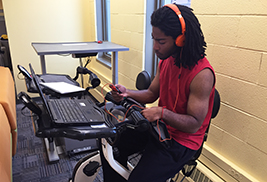Featured Article
Kent State University Library Adds New Amenities and Events This Fall
A treadmill, stationary bike, Frappuccino machines and more are some new features at the Kent State University Library.
read moreJoint Study by Kent State University and University of Toronto Finds Sochi Olympic Games Failed Women
Posted Oct. 12, 2015 | Beth ThomasKent State University researcher Michele K. Donnelly, Ph.D., and University of Toronto researchers Peter Donnelly, Ph.D., and Mark Norman found that the Sochi 2014 Winter Olympics failed to bring more women into the competition. Only 40 percent of competitors were women, making this the first time since 1988 that the percentage of women athletes saw a decline.
The researchers published their results in a report titled The Sochi 2014 Olympics: A Gender Equality Audit and found the gender disparity alarming since the International Olympic Committee’s (IOC) commitment to “act against any form of discrimination affecting the Olympic Movement” received considerable attention during Sochi 2014 because of Russia’s anti-gay laws.
Only 40.3 percent of the 2,866 athletes competing in the Sochi 2014 Olympic Games were women. This was a proportionate decrease from the Vancouver 2010 Olympic Games, where women made up 40.7 percent of the athletes competing. This drop occurred despite a steady growth in the Winter Olympics over the last 20 years with the number of total athletes increasing 65.4 percent and total the number of events increasing from 61 to 98.
The increasing numbers of women’s events are likely responsible, in part, for these overall increases. However, there has been no corresponding decline in the number of men’s events or male participants.
“Gender inequality at the Olympic Games is most obvious with respect to the relative numbers of women and men participating as athletes, and the relative numbers of women’s and men’s events,” says Michele K. Donnelly, assistant professor in Kent State’s College of Education, Health and Human Services. “However, it is also important to analyze the differences in the rules and structure of competition of women’s events compared to men’s events. These differences (for example, if men and women race different distances, men consistently race over longer distances than women) send important messages of concern about women’s abilities and potential as athletes.”
“The final hurdle [to equality] remains the International Sport Federations who administer each of the Olympic sports,” says Peter Donnelly, professor in the University of Toronto’s Faculty of Kinesiology and Physical Education. “They are the ones that determine the events for men and women and the quotas of athletes for the events. However, the events and the quotas for Olympic Games must be approved by the IOC; so we hope to see a real shift toward gender equality over the next few Olympics.”
For more information about research from the College of Education, Health and Human Services at Kent State, visit www.kent.edu/ehhs.
For more information about research from the Faculty of Kinesiology and Physical Education at the University of Toronto, visit www.physical.utoronto.ca.
